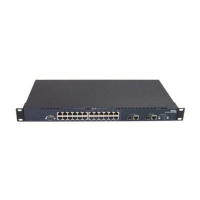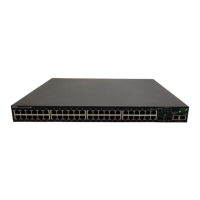BigIron RX Series Configuration Guide 867
53-1002253-01
Chapter
28
Configuring IS-IS (IPv4)
The Intermediate System to Intermediate System (IS-IS) protocol is a link-state Interior Gateway
Protocol (IGP) that is based on the International Standard for Organization/International
Electrotechnical Commission (ISO/IEC) Open Systems Internet Networking model (OSI). In IS-IS, an
intermediate system (router) is designated as either a Level 1 or Level 2 router. A Level 1 router
routes traffic only within the area in which the router resides. A Level 2 router routes traffic
between areas within a routing domain.
The Brocade implementation of IS-IS is based on the following specifications and draft
specifications:
• ISO/IEC 10589 – “Information Technology – Telecommunication and information exchange
between systems – Intermediate system to Intermediate system intra-domain routing
information exchange protocol for use in conjunction with the protocol for providing the
connection less-mode Network Service (ISO 8473)”, 1992
• ISO/IEC 8473 – “Information processing systems – Data Communications – Protocols for
providing the connectionless-mode network service”, 1988
• ISO/IEC 9542 – “Information Technology – Telecommunication and information exchange
between systems – End system to Intermediate system intra-domain routing information
exchange protocol for use in conjunction with the protocol for providing the connection
less-mode Network Service (ISO 8473)”, 1988
• RFC 1195 – “Use of OSI IS-IS for Routing in TCP/IP and Dual Environments”, 1990.
• RFC 2763 – “Dynamic Host Name Exchange Mechanism for IS-IS”, 2000.
• RFC 2966 – “Domain-wide Prefix Distribution with Two-Level IS-IS”, 2000
• Portions of the Internet Draft “IS-IS extensions for Traffic Engineering”
draft-ieff-isis-traffic-02.txt (dated 2000) that describe the Extended IP reachability TLV (TLV
type 135) and the extended Intermediate System (IS) reachability TLV (TLV type 22). These
portions provide support for the wide metric version of IS-IS. No other portion is supported on
Brocade’s implementation of IS-IS.
The BigIron RX does not support routing of Connectionless-Mode Network Protocol (CLNP) packets.
The device uses IS-IS for TCP/IP only.
Relationship to IP route table
The IS-IS protocol has the same relationship to the device’s IP route table that OSPF has to the IP
route table. The IS-IS routes are calculated and first placed in the IS-IS route table. The routes are
then transferred to the IP route table.
The protocol sends the best IS-IS path for a given destination to the IP route table for comparison to
the best paths from other protocols to the same destination. The CPU selects the path with the
lowest administrative distance and places that path in the IP route table.

